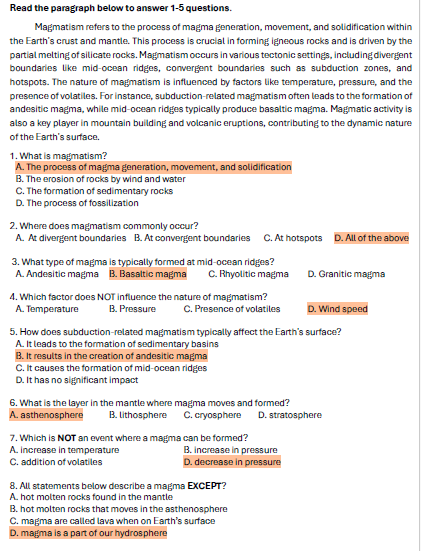What is magmatism? Where does magmatism commonly occur? What type of magma is typically formed at mid-ocean ridges? Which factor does NOT influence the nature of magmatism? How doe... What is magmatism? Where does magmatism commonly occur? What type of magma is typically formed at mid-ocean ridges? Which factor does NOT influence the nature of magmatism? How does subduction-related magmatism typically affect the Earth's surface? What is the layer in the mantle where magma moves and formed? Which is NOT an event where a magma can be formed? All statements below relate to magma EXCEPT? What roles does magma play?

Understand the Problem
The question is based on a paragraph about magmatism and requires understanding its processes, types of magma, and various factors influencing magmatism. Each sub-question seeks specific details related to these concepts.
Answer
1. A, 2. D, 3. B, 4. D, 5. B, 6. A, 7. D, 8. D
The final answers are as follows: 1. A, 2. D, 3. B, 4. D, 5. B, 6. A, 7. D, 8. D
Answer for screen readers
The final answers are as follows: 1. A, 2. D, 3. B, 4. D, 5. B, 6. A, 7. D, 8. D
More Information
Magmatism involves the generation, movement, and solidification of magma, which typically occurs at tectonic boundaries. Mid-ocean ridges generally produce basaltic magma. Wind speed does not influence magmatism. Subduction-related magmatism contributes to mountain building. The asthenosphere is the mantle layer where magma moves. Decrease in pressure is not an event where magma can be formed, and magma is not part of the hydrosphere.
Sources
- Magmatism - an overview | ScienceDirect Topics - sciencedirect.com
- 3 Magma, Melting, and Crystallization – Open Petrology - opengeology.org
- 4 Igneous Processes and Volcanoes – An Introduction to Geology - opengeology.org
AI-generated content may contain errors. Please verify critical information